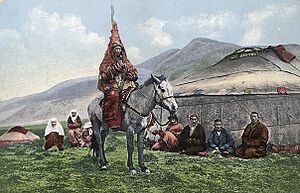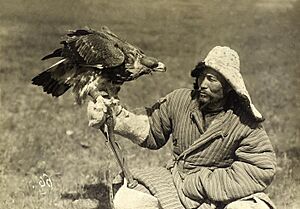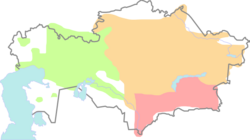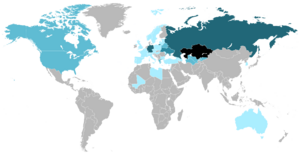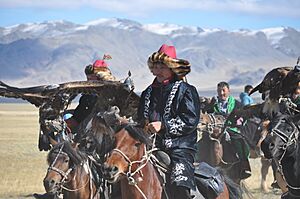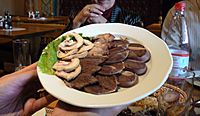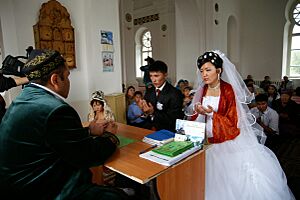Kazakhs facts for kids
| Қазақтар Qazaqtar |
|
|---|---|
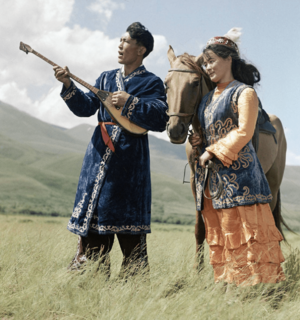 |
|
| Regions with significant populations | |
| 14,220,321 | |
| 1,562,518 | |
| 821,172 | |
| 591,970 | |
| 101,526 | |
| 36,854 | |
| 21,913 | |
| 10,000 | |
| 6,600 | |
| 3,000–15,000 | |
| 5,639 | |
| 5,526 | |
| 5,432 | |
| 5,000 | |
| 3,000 | |
| 1,924 | |
| 2,430 | |
| 1,685 | |
| 1,355 | |
| 1000 | |
| 200 | |
| 178–215 | |
| Languages | |
| Kazakh | |
| Religion | |
| Predominantly Islam | |
| Related ethnic groups | |
| Karakalpak, Nogai, Kyrgyz | |
The Kazakhs (also spelled Qazaqs) are a Turkic group of people. They mostly live in Central Asia and Eastern Europe. Their main home is Kazakhstan, but many also live in parts of Uzbekistan, Russia, northwestern China, and western Mongolia. The Kazakh people came together in the 1400s from different tribes of Turkic and Mongol backgrounds.
The idea of being "Kazakh" started in the Middle Ages. It was strongly shaped by the creation of the Kazakh Khanate (a type of kingdom) between 1456 and 1465. At that time, a large Mongol state called the Golden Horde broke apart. Some tribes, led by sultans Janibek and Kerei, left another khanate. They hoped to form their own powerful kingdom.
The word Kazakh refers to people who are ethnically Kazakh. The word Kazakhstani refers to anyone who is a citizen of Kazakhstan, no matter their background.
Contents
What Does "Kazakh" Mean?
Kazakhs likely started using the name "Kazakh" in the 1400s. There are many ideas about where the word "Kazakh" or "Qazaq" comes from. Some think it comes from the Turkic word qaz. This word means "wanderer, warrior, free, or independent."
Another idea is that it comes from the old Turkic word *khasaq. This was a wheeled cart that Kazakhs used to move their yurts (round tents) and belongings. An older Turkic word, qazğaq, was mentioned on an 8th-century monument. Some experts believe qazğaq means a person who wanders and seeks to gain things.
A Look at Kazakh History
For a long time, Kazakhstan was home to many nomadic groups on the Eurasian Steppe. These included the Sakas, Xiongnu, and the Mongol Empire. The Kazakh Khanate was set up in 1465.
The first Turkic peoples might have come from Southern Siberia and Mongolia. Early Turkic groups who moved into Central Asia had genes similar to ancient Northeast Asians. The Kazakhs became a distinct group in the early 1400s. They formed from several nomadic groups who spoke Turkic languages. These groups lived in northern Central Asia and southern Siberia, in a large area called the Kazakh Steppe. These tribes formed a strong group that became rich from trade along the famous Silk Road.
The word "Kazakh" was often used in medieval Central Asia. It usually referred to people or groups who had become independent from a ruler. For example, Timur described his own youth without direct authority as his Qazaqliq, meaning "freedom" or "Kazakh-ness."
In the 15th century, nomads of the Golden Horde were called Uzbeks. This was because they became Muslim under Uzbek Khan. The Kazakh identity came from this group. It happened when nomads in the eastern Qipchaq Steppe split into Kazakhs and Shibanid Uzbeks around the 1500s.
At the time of the Uzbek takeover of Central Asia, Abu'l-Khayr Khan had disagreements with sultans Kerei and Janibek. Kerei and Janibek moved with many nomads to the Zhetysu region. They set up new lands there with the support of Esen Buqa II, a ruler of Moghulistan. He hoped they would create a protective area against other groups.
A historian named Haidar Dughlat wrote about these events:
At that time, Abulkhair Khan had full power. Jáni Beg Khán and Karáy Khán ran from him into Moghulistán. Isán Bughá Khán welcomed them and gave them land near Chu. They lived there peacefully. When Abulkhair Khán died, the Uzbeks became confused, and fighting started. Most of them joined Karáy Khán and Jáni Beg Khán. There were about 200,000 people, and they were called Uzbeg-Kazák. The Kazák Sultáns began to rule around 1465–1466 AD. They ruled most of Uzbegistán until about 1533–1534 A. D.
In the 1600s, Russians started spelling "Kazakh" with "kh" at the end. This was to tell them apart from the Cossacks of the Russian army.
- Kazakh - Казах, /kazax/
- Cossack - Казак, /kazak/
The Ukrainian word Cossack probably comes from the same root. It means wanderer, bandit, or independent fighter.
Stories Passed Down
Like many nomadic people, Kazakhs have a long history of stories passed down by word of mouth. These stories are often told through songs (kyi) and poems (zhyr). They usually tell about Kazakh national heroes.
Kazakh oral traditions sometimes have political messages. The famous poet Abai Qunanbaiuly thought it was a great way to share ideas about adopting Western ways. These traditions have also helped to build pride in Kazakh identity.
The Three Kazakh Hordes
In Kazakhstan today, the importance of tribes in business and government is fading. However, it is still common for Kazakhs to ask about each other's tribe when they meet. This is more of a tradition now, and there is no fighting between tribes. Kazakhs see themselves as one nation, no matter their tribal background.
Modern Kazakhs who remember their tribes know that their tribes belong to one of three Zhuz (pronounced "jooz"). Zhuz can be translated as "horde" or "hundred":
- The Senior Horde (also called Elder or Great) (Uly juz)
- The Middle (also called Central) (Orta juz)
- The Junior (also called Younger or Lesser) (Kishi juz)
How the Hordes Started
There is much discussion about how the Hordes began. We don't know their exact age from old historical texts. The earliest mentions are from the 1600s. One idea is that the Hordes formed after the Kazakhs captured important cities in 1598. This separated the Kazakhs as they spread out from Zhetysu into a larger area. They focused on trade through the cities along the middle Syr Darya river. The Junior Horde came from the Nogais of the Nogai Horde.
The Kazakh Language
The Kazakh language is part of the Turkic language family. Other languages in this family include Uzbek, Kyrgyz, and modern Turkish. These languages are spoken in Eastern Europe, Central Asia, and Siberia.
Kazakh belongs to the Kipchak (Northwestern) group of Turkic languages. Kazakh has some unique sounds compared to other Turkic languages. Like most Turkic languages, Kazakh does not have long or short vowels.
Kazakh was written using the Arabic alphabet until the mid-1800s. After a revolt against Russia, Russia set up schools and tried to use the Cyrillic alphabet. This was not widely accepted. By 1917, the Arabic script was used again, even in schools.
In 1927, a Kazakh nationalist movement started against the Soviet Union. It was quickly stopped. As a result, the Arabic script was banned, and the Latin alphabet was used instead. To make Kazakhs more like Russians, the Latin alphabet was replaced by the Cyrillic alphabet in 1940. Today, there are efforts to go back to the Latin script. In January 2021, the government announced plans to switch to the Latin alphabet.
Kazakh is the official language in Kazakhstan. It is also spoken in the Ili region of Xinjiang, China, where the Arabic script is used. It is also spoken in western Mongolia, where the Cyrillic script is used. Kazakhs in Europe use the Latin alphabet.
Kazakh Population
| 1897 | 1917 | 1926 | 1937 | 1959 | 1979 | 1989 | 1999 | 2009 | 2021 | 2024 |
|---|---|---|---|---|---|---|---|---|---|---|
| 81.7% | 68.0% | 58.5% | 39.8% | 29.8% | 36.2% | 40.1% | 53.5% | 63.1% | 70.4% | 71% |
Historical population of Kazakhs:
| Year | Population in Kazakhstan |
|---|---|
| 1897 | 3,392,700 |
| 1917 | 4,615,000 |
| 1926 | 3,627,612 |
| 1937 | 2,181,520 |
| 1959 | 2,794,966 |
| 1979 | 5,289,349 |
| 1989 | 6,527,549 |
| 1999 | 8,011,452 |
| 2009 | 10,096,763 |
| 2021 | 13,497,891 |
| 2024 | 14,220,321 |
The number of ethnic Kazakhs dropped greatly between 1897 and 1959. This was due to the policies of the Russian Empire and a terrible famine during the Stalin era. This famine is described in the book "The Hungry Steppe: Famine, Violence, and the Making of Soviet Kazakhstan."
Kazakhs Around the World
In Russia
In Russia, Kazakhs mainly live in areas that border Kazakhstan. In 2002, there were 654,000 Kazakhs in Russia. Most of them live in regions like Astrakhan, Volgograd, and Orenburg. Even though they are ethnically Kazakh, they became Russian citizens after the dissolution of the Soviet Union in 1991.
| 1939 | % | 1959 | % | 1970 | % | 1979 | % | 1989 | % | 2002 | % | 2010 | % | 2020 | %1 |
|---|---|---|---|---|---|---|---|---|---|---|---|---|---|---|---|
| 356 646 | 0.33 | 382 431 | 0.33 | 477 820 | 0.37 | 518 060 | 0.38 | 635 865 | 0.43 | 653 962 | 0.45 | 647 732 | 0.45 | 591 970 | 0.45 |
| 1:of those who responded | |||||||||||||||
In China

Kazakhs moved into Dzungaria in the 1700s. This happened after many native Buddhist Dzungar people were killed.
Kazakhs are one of the 56 ethnic groups officially recognized by China. In 2020, there were 1,562,518 Kazakhs in China. Thousands of Kazakhs fled to China during a famine in Kazakhstan in 1932–1933.
In China, there is one Kazakh autonomous prefecture, the Ili Kazakh Autonomous Prefecture. There are also three Kazakh autonomous counties.
Some reports state that many Uyghurs, Kazakhs, and other Muslims in Xinjiang have been held in "reeducation camps." Chinese authorities say these centers are for job training and to fight against extremism.
In Mongolia
In the 1800s, Russian troops moved forward, pushing Kazakhs into neighboring countries. Around 1860, some Middle Jüz Kazakhs came to Mongolia. They were allowed to settle in Bayan-Ölgii, Western Mongolia. For most of the 1900s, they remained a close-knit community.
Most ethnic Kazakhs in Mongolia live in Bayan-Ölgii Province. Some Kazakh communities can also be found in other cities and towns across the country, like Ulaanbaatar.
| 1956 | % | 1963 | % | 1969 | % | 1979 | % | 1989 | % | 2000 | % | 2010 | % | 2020 | % |
|---|---|---|---|---|---|---|---|---|---|---|---|---|---|---|---|
| 36,729 | 4.34 | 47,735 | 4.69 | 62,812 | 5.29 | 84,305 | 5.48 | 120,506 | 6.06 | 102,983 | 4.35 | 101,526 | 3.69 | 121,000 | 3.81 |
In Uzbekistan
At the start of 2021, over 821,000 ethnic Kazakhs lived in Uzbekistan. They mostly live in Karakalpakstan and northern Uzbekistan.
In Iran
During the Qajar period, Iran bought Kazakh people who were wrongly sold as Kalmyks by slave traders.
Kazakhs from the Aday tribe lived in border areas of the Russian Empire with Iran since the 1700s. In 1870, a Kazakh rebellion against Russia led to many Kazakhs becoming refugees in Iran.
Iranian Kazakhs mainly live in Golestan Province in northern Iran. In 1982, about 3,000 Kazakhs lived in the city of Gorgan. Since the Soviet Union ended, the number of Kazakhs in Iran has gone down as many have moved back to Kazakhstan.
In Afghanistan
Kazakhs fled to Afghanistan in the 1930s to escape harsh treatment. One historian says there were between 20,000 and 24,000 Kazakhs in Afghanistan in 1978. Some blended in with local people and no longer speak Kazakh.
As of 2021, about 200 Kazakhs remain in Afghanistan. Locals say many live in Kunduz and other provinces like Takhar and Baghlan.
In Turkey
Turkey welcomed Kazakhs who were refugees from Pakistan. These were people who originally came from Afghanistan during the Soviet–Afghan War. In 1954 and 1969, Kazakhs also moved to areas in Anatolia. Turkey became a home for many Kazakh refugees.
Kazakh Culture
Food
Traditional Kazakh cuisine mainly uses lamb and horse meat. It also includes many milk products. For hundreds of years, Kazakhs were herders. They raised fat-tailed sheep, Bactrian camels, and horses. These animals provided them with transport, clothing, and food. Their cooking methods were greatly shaped by their nomadic life. For example, many cooking techniques focus on keeping food fresh for a long time. They often salt and dry meat. They also prefer sour milk, as it lasts longer when traveling.
Besbarmak is the most popular Kazakh dish. It is made of boiled horse or lamb meat. Besbarmak is usually eaten with boiled pasta sheets and a meat broth called shorpa. It is traditionally served in Kazakh bowls called kese. Other popular meat dishes include kazy (a horse meat sausage) and kuyrdak (roasted organs like heart and liver). Pilaf (palaw) is a common rice dish with vegetables and meat. The national drinks are kumys (fermented mare's milk) and tea.
Clothing
Traditional Kazakh clothing is made from materials that suit the region's harsh weather. It also fits the nomadic lifestyle of rural Kazakhs. Clothes are often decorated with fancy designs made from bird beaks, animal horns, and hooves. Today, Kazakhs usually wear Western clothes. However, they wear traditional clothing for holidays and special events.
Religion
Most Kazakhs today practice Sunni Islam. In the late 1300s, the Golden Horde spread Islam in its state. Islam became very important in Kazakhstan during the time of the Kazakh Khanate. This was especially true under rulers like Ablai Khan. More Kazakhs became Muslim in the 1400s and 1500s through the work of Sufi groups.
In the 1700s, Russia's influence grew in Central Asia. At first, the Russians allowed Islam to grow. They invited Muslim religious leaders to teach the Kazakhs. However, Russian policy slowly changed to weaken Islam. They tried to bring back older, pre-Islamic ideas. They also tried to make Kazakhs feel less important. In response, Kazakh religious leaders tried to promote a sense of shared Turkic identity. Many were punished for this.
During the Soviet era, Muslim groups survived only where Kazakhs greatly outnumbered non-Muslims. To make Kazakhs follow Communist ideas, gender roles and other parts of Kazakh culture were targeted for change.
More recently, after the fall of the Soviet Union, Kazakhs have worked to bring back Islamic religious groups. Most Kazakhs still feel connected to their Islamic faith, especially in the countryside. People who say they are descendants of early Muslim soldiers and teachers are highly respected. Kazakh leaders have also said it is important to support Islamic awareness.
Older beliefs, like worshipping the sky, ancestors, and fire, were still common among ordinary people. Kazakhs believed in good and evil spirits. They wore special beads and charms to protect themselves. Beliefs in shamans, called bakhsy, are also still common. Unlike Siberian shamans who used drums, Kazakh shamans played a stringed instrument like a large violin. Today, both Islamic and older beliefs are found among Kazakhs, especially older people. In 2009, about 39,172 ethnic Kazakhs were Christians.
Traditions
Kazakhs are known for being very welcoming. Many Kazakh traditions are based on this. Some traditions have been lost, but others have been rediscovered. Here are some traditions still important in modern Kazakh society:
- Konakasy (Kazakh: қонақасы; "konak" – guest, "as" – food) – This is a tradition to welcome a guest. It means making their stay as pleasant as possible by providing food, a place to stay, and entertainment. Depending on why a guest came, they might be called "arnayy konak" (a specially invited guest), "kudayy konak" (a casual traveler), or "kydyrma konak" (an unexpected visitor).
- Korimdik (Kazakh: көрімдік; "koru" – to see) – This is a tradition of giving a gift to congratulate someone on something new in their life. It's called korimdik if it's about a person or animal (like seeing a new daughter-in-law or a newborn animal). It's called baygazy (байғазы) if the gain is something material, like a new item.
- Shashu (Kazakh: шашу – to scatter) – This tradition involves showering people celebrating an event with sweets. Kazakhs believe that collecting these sweets brings good luck.
- Bata (Kazakh: бата – blessing) – This is a type of poetic blessing. It is usually given by the most respected or oldest person. It can be to thank someone for their hospitality, or to bless someone starting a new part of their life, facing a challenge, or traveling.
- Tusau kesu (Kazakh: тұсау кесу – to cut ties) – This tradition celebrates a child's first attempts to walk. The child's legs are tied with a string of white and black colors. These colors represent the good and bad parts of life. A lively female relative then cuts the string, so the child can gain her good qualities. After the string is cut, it is burned.
- Kyz uzatu (Kazakh: қыз ұзату) – This is the first wedding party, organized by the bride's parents. It literally means "to see off a daughter."
- Betashar (Kazakh: беташар; "bet" – face, "ashu" – to open) – This custom is often done at a wedding. It involves lifting a veil from the bride's face. Today, a religious leader (mullah) often sings a song. In the song, he names the groom's relatives. The bride bows each time a name is mentioned. After the song, the groom's mother lifts the veil.
- Shildehana (Kazakh: шілдехана) – This is a celebration for the birth of a child.
- Suinshi (Kazakh: сүйінші) – This is a tradition of giving a gift to someone who brings good news.
Music
One of the most common traditional Kazakh musical instruments is the dombra. It is a two-stringed instrument that is plucked. It often goes along with singing. Another popular instrument is the kobyz, a bowed instrument played on the knees. Both instruments are very important in traditional Kazakh orchestras.
A famous composer was Kurmangazy, who lived in the 1800s. Gaziza Zhubanova became the first woman classical composer in Kazakhstan. Her music shows Kazakh history and folk stories. A well-known singer from the Soviet era was Roza Rymbaeva, who was famous across the Soviet Union. Urker is a notable Kazakh rock band that mixes rock music with traditional Kazakh music.
Notable Kazakhs
See also
- Chala Kazakh
- Nogai people
- Kazakh Americans
- Kazakh Canadians
- Kazakhs in Russia
- Turkic peoples
- List of Kazakhs
- Ethnic demography of Kazakhstan


